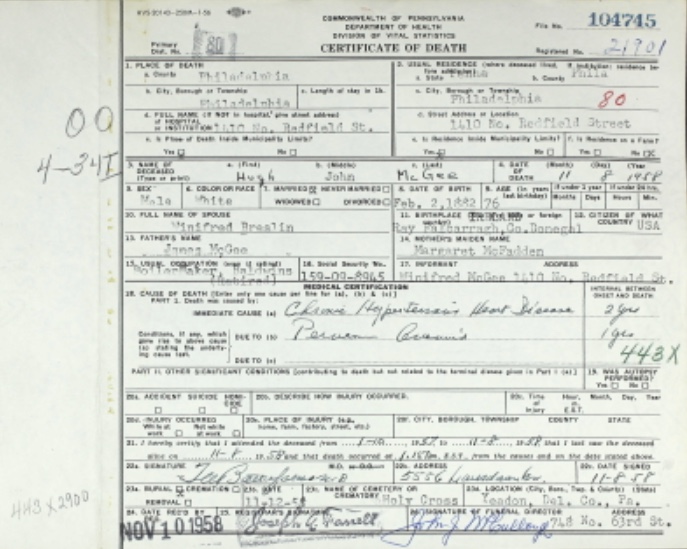In the search for our sometimes elusive ancestors, we all hit the proverbial brick wall. It’s incredibly frustrating when we get stuck on a particular line and can’t seem to find any new information. Sometimes, in order to find our own ancestors, we have to expand our tree to include not just our lines, but those of the other families in the neighborhood.
This is very true in researching Irish genealogy, where many families emigrated over multiple generations. It’s not unusual to discover the same surnames popping up in a town or region in Pennsylvania, and it can be a real challenge to figure out which Thomas Ryan or Bridget McGee is the one you’re looking for.
The coal mining regions of the north central parts of Pennsylvania in particular drew many immigrants from Ireland, and names associated with County Donegal families show up quite frequently. Which is why you see the counties of Lackawanna, Luzerne, Carbon, Schuylkill, Columbia and Northumberland filled with O’Donnells, Boyles, Gallaghers, Dohertys, McGees and McGills.
It’s a daunting task to sit down and try to sort out your line, but if your ancestors came to Pennsylvania in the late 1800s and early 1900s, there are two resources in particular that can be invaluable. Both are accessible only through subscription databases, but if you’re serious about finding your roots, they’re worth at least a short time membership. It’s going to take some dedication, and I definitely recommend taking a lot of notes and doing a lot of printing.
1. The first is the Pennsylvania, Death Certificates, 1906-1967, available at Ancestry. This is a treasure trove of information for anyone who has ancestors who died in Pennsylvania. For years, obtaining a Pennsylvania death record was a challenge, and a written request had to be accompanied by a check for the fee, together with a copy of your drivers license. And, the exact name and date and place of death had to be known in order for the search to be made. Now, with the original documents scanned in and searchable on Ancestry, you can get creative and innovative with your own searches. You don’t need to put in a first name; you can search with a county and a year. Or, you can find all the people who died in Pennsylvania on one particular day.
Want to know everyone whose last name was Gillespie who was born in Ireland between 1820 and 1830 and died in Pennsylvania after 1906? You can find out. It will tell you when and where they died, their approximate age (most people didn’t know their actual birthdays in those days), who the informant was, where they’re buried, and if you’re lucky enough, the names of their parents including their mother’s surname. Be careful, though—sometimes the person filling out the information didn’t know the parents names or got them wrong. But you can start to put together your ancestor’s siblings, spouses and even cousins from these records. Build out the family sideways and you can then move backwards. Your great grandfather’s death certificate might not have his mother’s maiden name on it, but his sister’s might.
2. The second is Newspapers. This can be accessed as a subscription through Ancestry, or on its own. If your ancestors happen to have lived in an area where the website has added the local newspaper, you’ve hit paydirt. And Pennsylvania is represented by many useful papers. In addition to the Philadelphia Inquirer, some of the newspapers included from the coal mining region are: The Morning Call (Allentown), The Times Tribune (Scranton), The Plain Speaker (Hazleton), and Pottsville Republican (Pottsville). Besides obituaries, these papers routinely reported on the comings and goings of the residents. It’s not unusual to find that “Mrs. Charles McGinnis just returned from visiting her brother, Thomas Dooley, in Phillipsburg, New Jersey” with the date of the visit noted. Something as seemingly insignificant as this item can connect your ancestors to siblings, cousins, parents…and provide you with previously unknown maiden names and other family members who also came over around the same time.
I also recommend creating a second, private “Theory Tree.” This is a tree just for you, where not everything has to be perfect. It’s a place where you can add all these potential new ancestral cousins. If you discover later on that some of the info you’ve entered there isn’t correct, you haven’t put any misinformation into the genealogy community. But it’s a way to make notes for yourself as you work out where some of these people with the same surnames may fit into your family.
Breaking though brick walls is an ongoing challenge. There are ALWAYS going to be brick walls. But having some strategies to work around them, or climb over them, like death record searches and local newspapers, can provide some great new clues.

